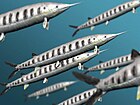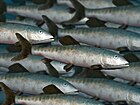Bananogmius
| Bananogmius Temporal range: Possible Albian record
| |
|---|---|

| |
| Artist's impression of B. aratus | |
| Scientific classification | |
| Domain: | Eukaryota |
| Kingdom: | Animalia |
| Phylum: | Chordata |
| Class: | Actinopterygii |
| Order: | †Tselfatiiformes |
| Family: | †Plethodidae |
| Genus: | †Bananogmius Whitley, 1940 |
| Type species | |
| †Anogmius aratus Cope, 1877
| |
| Species | |
| |
| Synonyms | |
| |
Bananogmius is an extinct genus of marine ray-finned fish that was found in what is now North America and Europe during the Late Cretaceous, from the Cenomanian to the Santonian.[1] It lived in the Western Interior Seaway, which split North America in two during the Late Cretaceous, as well as the proto-North Sea of Europe.[2][3][4]
Taxonomy[edit]
The original name for this genus was Anogmius Cope, 1871, which was described with the type species A. contractus. Shortly afterwards, Cope synonymized the genus with Pachyrhizodus, only to revive it in 1877 for species such as A. aratus, A. favirostris, and A. evolutus. Cope's synonymy of this genus with Pachyrhizodus was variously accepted or rejected for several decades, until 1940 when the new genus Bananogmius was proposed to contain all members of Anogmius aside from the type species, which was assumed to be a synonym of Pachyrhizodus. Further analysis of Cope's description of the original Anogmius contractus confirms that it was a plethodid and not a pachyrhizodontid, but this specimen was too fragmentary for a proper diagnosis and is now lost, leaving Bananogmius as the valid name.[1]
The following species are known:[1]
- †B. aratus (Cope, 1877) - Turonian to Santonian of the Niobrara Chalk in Kansas, USA (type species) (=Anogmius aratus Cope, 1877)
- †B. favirostris (Cope, 1877) - Turonian to Santonian of the Niobrara Chalk in Kansas, USA (=Anogmius favirostris Cope, 1877)
- †B. ellisensis Fielitz & Shimada, 1999 - Turonian of the Carlile Shale in Kansas, USA[5]
- †B. ornatus (Woodward, 1923) - Cenomanian of England (Chalk Group), Cenomanian/Turonian of Germany (=Anogmius ornatus Woodward, 1923)[4][6][7]
Specimens are known from the Turonian and possibly the Albian (Tlayúa Formation) of Mexico, although these have not yet been described.[8] Some species formerly placed in this genus, such as B. evolutus Cope, 1877 and B. crieleyi Applegate, 1970 were later reclassified as Pentanogmius.[9]
Description[edit]
As with many plethodids, Bananogmius had a thin body reminiscent of the modern angelfish, dozens of small teeth, and a high dorsal fin.[10]
Ecology[edit]
Bananogmius appears to have been a medium-sized predator that swallowed its prey headfirst. A fossil of B. ornatus from Germany from around the Cenomanian-Turonian boundary is preserved with the skeletons of the small schooling fish Clupavus in its stomach.[4] This fish also has crushing teeth, indicating that it may have preyed upon marine mollusks.[5]
References[edit]
- ^ a b c Taverne, Louis (2001). "Révision du genre Bananogmius (Teleostei, Tselfatiiformes), poisson marin du Crétacé supérieur d'Amérique du Nord et d'Europe". Geodiversitas. 23 (1): 17–40.
- ^ Fielitz C, Shimada K. 1999. A new species of Bananogmius (Teleostei; Tselfatiformes) from the Upper Cretaceous Carlile Shale of western Kansas. Journal of Paleontology 73(3): 504-511.
- ^ Taverne L. 2001. Révision du genre Bananogmius (Teleostei, Tselfatiiformes), poisson marin du Crétecé supérior d'Amérique du Nord et d'Europe. Geodiversitas 23(1):17-40.
- ^ a b c Hunt, Adrian P.; Milàn, Jesper; Lucas, Spencer G.; Spielmann, Justin A. (2012). Vertebrate Coprolites: Bulletin 57. New Mexico Museum of Natural History and Science.
- ^ a b Fielitz, Christopher; Shimada, Kenshu (1999). "A new species of Bananogmius (Teleostei: Tselfatiformes) from the Upper Cretaceous Carlile Shale of western Kansas". Journal of Paleontology. 73 (3): 504–511. Bibcode:1999JPal...73..504F. doi:10.1017/S0022336000028018. ISSN 0022-3360.
- ^ Friedman, Matt; Beckett, Hermione T.; Close, Roger A.; Johanson, Zerina (2016). "The English Chalk and London Clay: two remarkable British bony fish Lagerstätten". Geological Society, London, Special Publications. 430 (1): 165–200. Bibcode:2016GSLSP.430..165F. doi:10.1144/SP430.18. ISSN 0305-8719.
- ^ Amalfitano, Jacopo; Giusberti, Luca; Fornaciari, Eliana; Carnevale, Giorgio (2020-04-03). "Upper Cenomanian Fishes From the Bonarelli Level (OAE2) of Northeastern Italy". Rivista Italiana di Paleontologia e Stratigrafia. 126 (2). doi:10.13130/2039-4942/13224. ISSN 2039-4942.
- ^ Stinnesbeck, Eva Susanne; Herder, Fabian; Rust, Jes; Stinnesbeck, Wolfgang (2023-02-01). "Taphonomy of the teleost Tselfatia formosa Arambourg, 1943 from Vallecillo, NE Mexico". PLOS ONE. 18 (2): e0280797. Bibcode:2023PLoSO..1880797S. doi:10.1371/journal.pone.0280797. ISSN 1932-6203. PMC 9891505. PMID 36724176.
- ^ Taverna, L. (2000). "Ostéologie et position systématique du genre Plethodus et des nouveaux genres Dixonanogmius et Pentanogmius, poissons marins du Crétacé (Teleostei, Tselfatiiformes)". Biologisch Jaarboek Dodonaea. 67 (1): 94–123.
- ^ Everhart, Mike (23 Aug 2011). "Plethodids". Oceans of Kansas. Retrieved 28 April 2014.
- Tselfatiiformes
- Prehistoric ray-finned fish genera
- Late Cretaceous bony fish
- Late Cretaceous fish of North America
- Cretaceous fish of Europe
- Cenomanian genus first appearances
- Turonian genera
- Coniacian genera
- Santonian genus extinctions
- Fossils of the United States
- Fossils of Mexico
- Fossils of England
- Fossils of Germany
- Natural history of Kansas
- Fossil taxa described in 1940
- Prehistoric ray-finned fish stubs







